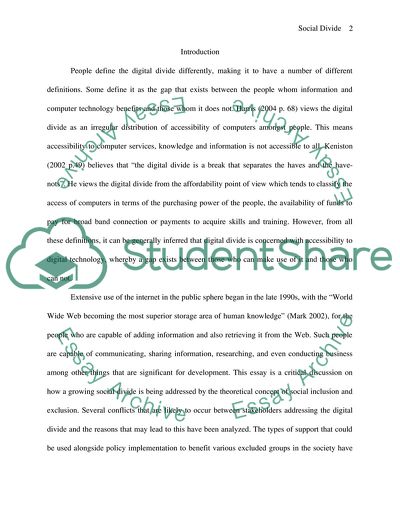Cite this document
(Addressing the Digital Divide Research Paper Example | Topics and Well Written Essays - 3000 words, n.d.)
Addressing the Digital Divide Research Paper Example | Topics and Well Written Essays - 3000 words. Retrieved from https://studentshare.org/information-technology/1723377-drawing-on-the-key-themes-presented-in-this-course-unit-discuss-critically-how-a-growing-social-divide-is-being-addressed-by-the-theoretical-concept-of-social-inclusion-exclusion
Addressing the Digital Divide Research Paper Example | Topics and Well Written Essays - 3000 words. Retrieved from https://studentshare.org/information-technology/1723377-drawing-on-the-key-themes-presented-in-this-course-unit-discuss-critically-how-a-growing-social-divide-is-being-addressed-by-the-theoretical-concept-of-social-inclusion-exclusion
(Addressing the Digital Divide Research Paper Example | Topics and Well Written Essays - 3000 Words)
Addressing the Digital Divide Research Paper Example | Topics and Well Written Essays - 3000 Words. https://studentshare.org/information-technology/1723377-drawing-on-the-key-themes-presented-in-this-course-unit-discuss-critically-how-a-growing-social-divide-is-being-addressed-by-the-theoretical-concept-of-social-inclusion-exclusion.
Addressing the Digital Divide Research Paper Example | Topics and Well Written Essays - 3000 Words. https://studentshare.org/information-technology/1723377-drawing-on-the-key-themes-presented-in-this-course-unit-discuss-critically-how-a-growing-social-divide-is-being-addressed-by-the-theoretical-concept-of-social-inclusion-exclusion.
“Addressing the Digital Divide Research Paper Example | Topics and Well Written Essays - 3000 Words”, n.d. https://studentshare.org/information-technology/1723377-drawing-on-the-key-themes-presented-in-this-course-unit-discuss-critically-how-a-growing-social-divide-is-being-addressed-by-the-theoretical-concept-of-social-inclusion-exclusion.


